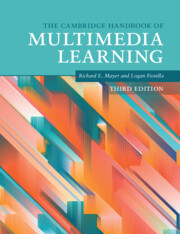Book contents
- The Cambridge Handbook of Multimedia Learning
- The Cambridge Handbook of Multimedia Learning
- Copyright page
- Contents
- Figures
- Tables
- Contributors
- Preface
- Acknowledgments
- Part I Background
- Part II Theoretical Foundations
- Part III Basic Principles of Multimedia Learning
- Part IV Principles for Reducing Extraneous Processing in Multimedia Learning
- Part V Principles for Managing Essential Processing in Multimedia Learning
- Part VI Principles Based on Social and Affective Features of Multimedia Learning
- 22 Principles Based on Social Cues in Multimedia Learning
- 23 The Embodiment Principle in Multimedia Learning
- 24 The Immersion Principle in Multimedia Learning
- 25 The Collaboration Principle in Multimedia Learning
- 26 The Animation Composition Principle in Multimedia Learning
- 27 The Emotional Design Principle in Multimedia Learning
- Part VII Principles Based on Generative Activity in Multimedia Learning
- Part VIII Multimedia Learning with Media
- Author Index
- Subject Index
- References
24 - The Immersion Principle in Multimedia Learning
from Part VI - Principles Based on Social and Affective Features of Multimedia Learning
Published online by Cambridge University Press: 19 November 2021
- The Cambridge Handbook of Multimedia Learning
- The Cambridge Handbook of Multimedia Learning
- Copyright page
- Contents
- Figures
- Tables
- Contributors
- Preface
- Acknowledgments
- Part I Background
- Part II Theoretical Foundations
- Part III Basic Principles of Multimedia Learning
- Part IV Principles for Reducing Extraneous Processing in Multimedia Learning
- Part V Principles for Managing Essential Processing in Multimedia Learning
- Part VI Principles Based on Social and Affective Features of Multimedia Learning
- 22 Principles Based on Social Cues in Multimedia Learning
- 23 The Embodiment Principle in Multimedia Learning
- 24 The Immersion Principle in Multimedia Learning
- 25 The Collaboration Principle in Multimedia Learning
- 26 The Animation Composition Principle in Multimedia Learning
- 27 The Emotional Design Principle in Multimedia Learning
- Part VII Principles Based on Generative Activity in Multimedia Learning
- Part VIII Multimedia Learning with Media
- Author Index
- Subject Index
- References
Summary
The immersion principle in multimedia learning is that immersive virtual environments promote better learning when they incorporate multimedia design principles. In short, immersive media do not necessarily improve learning but effective instructional methods within immersive virtual environments do improve learning. The goal of effective instructional design in immersive virtual environments is to promote processes of selecting, organizing, and integrating information. Psychological presence – the subjective experience of “being there” – is an affective affordance of learning in immersive learning environments that can motivate learners to engage in deeper learning. The chapter also describes boundary conditions of immersive virtual environments, including the potential for instructional design to cause extraneous cognitive load and impose high metacognitive demands on learners. Multimedia learning principles developed based on research with less immersive media may generalize to learning in immersive environments.
- Type
- Chapter
- Information
- The Cambridge Handbook of Multimedia Learning , pp. 296 - 303Publisher: Cambridge University PressPrint publication year: 2021
References
- 16
- Cited by

